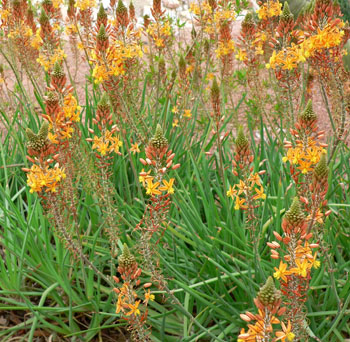Bulbine frutescens

Common: Yellow bulbine, Snake flower, Cat's tail, Burn jelly plant
Family: Asphodelaceae
Origin/Range: South Africa
Light: Full sun, light shade
Temp: Survives to 20°F or below but foliage is damaged
Water: Requires supplemental, water every week or once every two weeks
Soil: Adaptable, good drainage
Evergreen, clump-forming succulent. Height of 1.5ft, spread to 2ft. Tall fleshy green cylinder leaves, long and thin, similar to onion leaf blade. Tall spike of small yellow flowers; stalk to 2-3ft above foliage, 10-12 stalks per individual plant; bloom continually from mid-spring through fall. The petals are either yellow or sometimes orange, which combines attractively with the fluffy yellow stamens to give a bi-coloured look. The fruit is a small, rounded capsule and contains black seeds which are dispersed by wind
Can be used as accent plant; good in containers and in rock and cactus gardens. Low maintenance; remove old flower stalks, and any frost damage.
Bulbine comes from the Latin word bulbus meaning an onion or bulb. This name is misleading, as plants do not have a bulbous base.
The fresh leaf produces a jelly-like juice that is wonderful for burns, rashes, blisters, insect bites, cracked lips, acne, cold sores, mouth ulcers and areas of cracked skin. This plant is ideal to grow and is a useful first-aid remedy for childrens' daily knocks and scrapes. The Rastafarians make an infusion of a few fresh leaves in a cup of boiling water. The strained drink is taken for coughs, colds and arthritis.